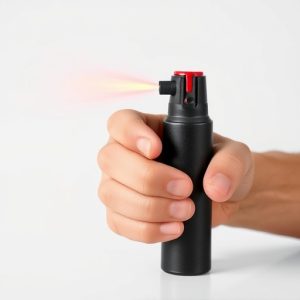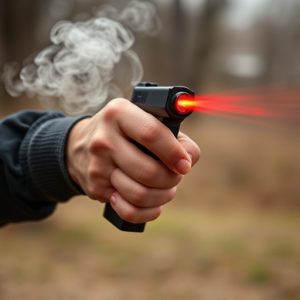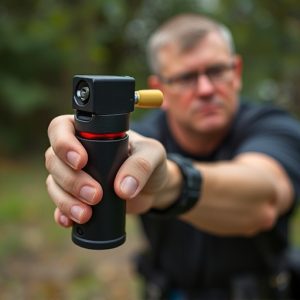Unveiling the Strongest Legal Pepper Spray Ingredients for Civilian Protection
Pepper spray, developed in the 1960s as a safer alternative to tear gas, is now a widely available s…….
Pepper spray, developed in the 1960s as a safer alternative to tear gas, is now a widely available self-defense tool regulated globally. The strongest legal pepper spray ingredients, like capsaicin from chili peppers, offer effective protection without causing permanent harm. While "strongest" labels are misleading, effectiveness depends on factors beyond ingredient strength. Formulations blending capsaicin, piperine, oleoresin capsicum (OC), and natural plant extracts are crucial for civilian protection, balancing potency with safety under local laws. Proper training, awareness, and maintenance ensure responsible use without causing excessive harm, reflecting personal safety and community security.
In today’s world, civilian protection against threats like assault and harassment is a growing concern. One effective tool gaining traction is inflammatory spray, also known as pepper spray. This article delves into the intricacies of this self-defense mechanism, focusing on the ‘strongest’ legal pepper spray ingredients, their history, and practical use cases. We explore the legal framework governing civilian possession and dissect what makes a spray potent while highlighting safety considerations for responsible use.
- Understanding Pepper Spray: Its History and Legal Framework
- Deciphering the 'Strongest' Label: What Does it Mean?
- Key Ingredients in Legal Pepper Spray Formulations
- Civilian Protection Use Cases and Effectiveness
- Safety, Training, and Responsible Use of Pepper Spray
Understanding Pepper Spray: Its History and Legal Framework
Pepper spray, a non-lethal self-defense tool, has evolved from its early days as a law enforcement weapon to become widely available for civilian protection. Originally developed in the 1960s by a research chemist seeking a safer alternative to tear gas, it quickly gained popularity among police forces due to its effectiveness in neutralizing aggressors without causing permanent harm. Today, pepper spray is not only legal in many countries but also regulated, ensuring consumers access the strongest legal pepper spray ingredients available while adhering to safety standards.
The legal framework surrounding pepper spray varies by region, with some countries allowing its sale and use for self-defense while others restrict it to law enforcement agencies. The most potent legal pepper spray formulations typically contain capsaicin, the active ingredient derived from chili peppers that causes the burning sensation associated with spicy food and irritates eyes, nose, and respiratory pathways. Other ingredients may include natural oils, foaming agents, or UV dyes for enhanced visibility during incidents. Understanding these legal parameters is crucial for consumers looking to protect themselves while ensuring they comply with local regulations.
Deciphering the 'Strongest' Label: What Does it Mean?
When shopping for an inflammatory spray for civilian protection, one of the most confusing aspects can be understanding the ‘strongest’ label. This term is often misused and misleading, as it doesn’t refer to the amount of active ingredient but rather the concentration of irritants and their potential to cause a strong reaction.
The ‘strongest’ legal pepper spray ingredients are typically those that contain higher concentrations of capsaicin, the main active compound in chili peppers responsible for the burning sensation. However, what makes a spray truly effective isn’t just about the strength of its ingredients but also the delivery system, can size, and the user’s sensitivity. It’s crucial to look beyond the ‘strongest’ label and consider factors like range, durability, and safety features to ensure you’re getting a product that suits your protection needs effectively.
Key Ingredients in Legal Pepper Spray Formulations
The strongest legal pepper spray formulations often contain a blend of key ingredients designed to disrupt an assailant’s vision, breathing, and overall mobility. These include capsaicin, the active compound derived from chili peppers, which is known for its powerful irritant properties. Other common components like piperine, a derivative of black pepper, enhance capsaicin’s effectiveness by increasing its absorption into the skin and mucous membranes.
In addition to these, legal pepper sprays may include various synthetic chemicals like oleoresin capsicum (OC), a concentrated form of capsaicin, which adds to their potency. Some advanced formulations also incorporate natural plant extracts, such as those from hot peppers or citrus fruits, for enhanced irritation and lingering effects. These ingredients collectively ensure that civilian protection spray remains effective against potential threats while adhering to legal standards.
Civilian Protection Use Cases and Effectiveness
Civilian protection is a growing concern for individuals seeking personal safety in public spaces. In such scenarios, inflammatory spray has emerged as a powerful tool to deter and incapacitate potential threats quickly. Use cases range from self-defense against attackers to crowd control during chaotic situations, making it a versatile option for civilians aiming to protect themselves and their loved ones.
When considering the effectiveness of these sprays, it’s crucial to look at the strongest legal pepper spray ingredients available. Capsaicin, often derived from chili peppers, is a widely used active ingredient known for its potent irritant properties. This compound temporarily blocks nerve signals, causing pain and disorientation in the target. The most effective formulations offer a balance between potency and safety, ensuring that civilians can use them responsibly without causing unnecessary harm.
Safety, Training, and Responsible Use of Pepper Spray
When considering an inflammatory spray for civilian protection, safety is paramount. It’s crucial to understand that these devices are powerful tools designed to incapacitate rather than harm. The strongest legal pepper spray ingredients, like capsaicin or oleoresin capsicum (OC), should only be used when absolutely necessary and in accordance with local laws. Training is essential; users must learn proper application techniques to ensure effectiveness while minimizing risks to bystanders and oneself.
Responsible use involves recognizing the spray’s limitations and potential side effects, such as respiratory distress or eye irritation. Users should be aware of their surroundings and ensure no one else is within range to avoid accidental exposure. Regular maintenance and knowledge of expiration dates are also vital for keeping the spray in optimal condition. Remember, the responsible use of pepper spray reflects not only on personal safety but also on the community’s overall security.
When considering civilian protection with inflammatory spray, it’s crucial to balance effectiveness with legal constraints. The strongest legal pepper spray ingredients, as established by key formulations, offer a robust defense while adhering to strict regulations. Understanding the history and legal framework guiding these products ensures responsible use. Safety training is paramount for civilians opting for self-defense, emphasizing the importance of proper handling and awareness of state laws. By navigating these aspects, individuals can make informed decisions, leveraging the strongest legal pepper spray ingredients for their protection needs while prioritizing safety and legality.


